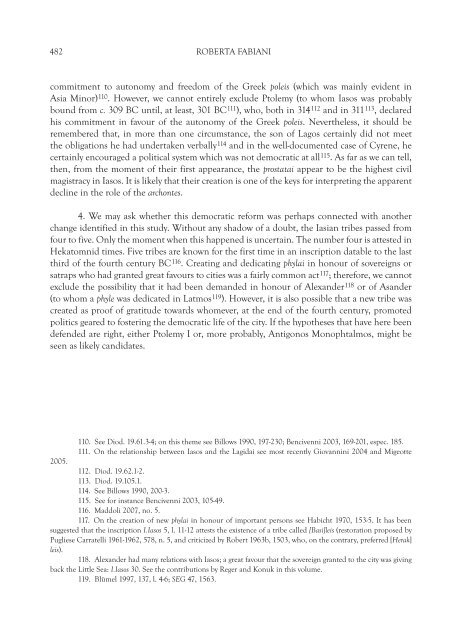hellenistic karia - Associazione Iasos di Caria
hellenistic karia - Associazione Iasos di Caria
hellenistic karia - Associazione Iasos di Caria
Create successful ePaper yourself
Turn your PDF publications into a flip-book with our unique Google optimized e-Paper software.
482 ROBERTA FABIANI<br />
commitment to autonomy and freedom of the Greek poleis (which was mainly evident in<br />
Asia Minor) 110 . However, we cannot entirely exclude Ptolemy (to whom <strong>Iasos</strong> was probably<br />
bound from c. 309 BC until, at least, 301 BC 111 ), who, both in 314 112 and in 311 113 , declared<br />
his commitment in favour of the autonomy of the Greek poleis. Nevertheless, it should be<br />
remembered that, in more than one circumstance, the son of Lagos certainly <strong>di</strong>d not meet<br />
the obligations he had undertaken verbally 114 and in the well-documented case of Cyrene, he<br />
certainly encouraged a political system which was not democratic at all 115 . As far as we can tell,<br />
then, from the moment of their first appearance, the prostatai appear to be the highest civil<br />
magistracy in <strong>Iasos</strong>. It is likely that their creation is one of the keys for interpreting the apparent<br />
decline in the role of the archontes.<br />
4. We may ask whether this democratic reform was perhaps connected with another<br />
change identified in this study. Without any shadow of a doubt, the Iasian tribes passed from<br />
four to five. Only the moment when this happened is uncertain. The number four is attested in<br />
Hekatomnid times. Five tribes are known for the first time in an inscription datable to the last<br />
third of the fourth century BC 116 . Creating and de<strong>di</strong>cating phylai in honour of sovereigns or<br />
satraps who had granted great favours to cities was a fairly common act 117 ; therefore, we cannot<br />
exclude the possibility that it had been demanded in honour of Alexander 118 or of Asander<br />
(to whom a phyle was de<strong>di</strong>cated in Latmos 119 ). However, it is also possible that a new tribe was<br />
created as proof of gratitude towards whomever, at the end of the fourth century, promoted<br />
politics geared to fostering the democratic life of the city. If the hypotheses that have here been<br />
defended are right, either Ptolemy I or, more probably, Antigonos Monophtalmos, might be<br />
seen as likely can<strong>di</strong>dates.<br />
110. See Diod. 19.61.3-4; on this theme see Billows 1990, 197-230; Bencivenni 2003, 169-201, espec. 185.<br />
111. On the relationship between <strong>Iasos</strong> and the Lagidai see most recently Giovannini 2004 and Migeotte<br />
2005.<br />
112. Diod. 19.62.1-2.<br />
113. Diod. 19.105.1.<br />
114. See Billows 1990, 200-3.<br />
115. See for instance Bencivenni 2003, 105-49.<br />
116. Maddoli 2007, no. 5.<br />
117. On the creation of new phylai in honour of important persons see Habicht 1970, 153-5. It has been<br />
suggested that the inscription I.<strong>Iasos</strong> 5, l. 11-12 attests the existence of a tribe called [Basi]leis (restoration proposed by<br />
Pugliese Carratelli 1961-1962, 578, n. 5, and criticized by Robert 1963b, 1503, who, on the contrary, preferred [herak]<br />
leis).<br />
118. Alexander had many relations with <strong>Iasos</strong>; a great favour that the sovereign granted to the city was giving<br />
back the Little Sea: I.<strong>Iasos</strong> 30. See the contributions by Reger and Konuk in this volume.<br />
119. Blümel 1997, 137, l. 4-6; SEG 47, 1563.



